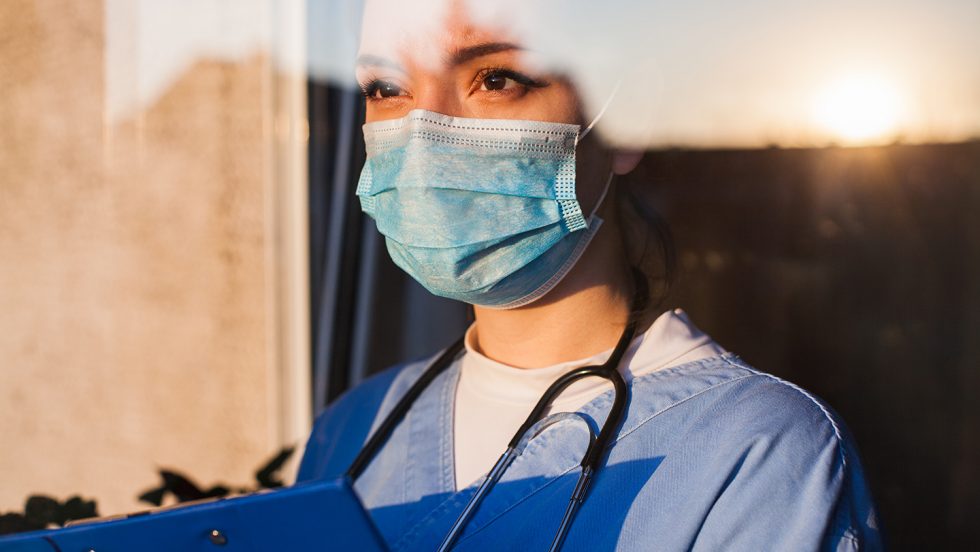
Shining a light on the struggles of vulnerable healthcare workers.
Home health aides (HHAs) are among the unsung heroes of America’s healthcare system. By assisting patients with countless daily tasks—such as bathing, cooking, grocery shopping and taking medications—they make it possible for the elderly to remain at home and part of their community. Yet despite providing an essential social service, these workers face low wages and high stress, a situation that became much more difficult during the COVID-19 pandemic.
 These pandemic-related challenges are the subject of the latest paper from Zainab Osakwe ‘06, PhD, assistant professor of public health at Adelphi, who has written extensively about home health aides’ experiences on the job, ranging from the dependency of their patients to the emerging use of telehealth services. For this latest project, conducted in partnership with former Adelphi professor Tonya Samuel, EdD, and colleagues from Long Island University and Columbia University, Dr. Osakwe interviewed 25 aides from around the New York metropolitan area, 12 of whom primarily spoke Spanish. Dr. Osakwe and her team sought to understand HHAs’ perspective on infection control and the obstacles associated with caring for the elderly at home during the pandemic. They shared their findings in “All Alone: A qualitative study of home health aides’ experiences during the COVID-19 pandemic in NewYork,” published in the American Journal of Infection Control on August 12, 2021.1
These pandemic-related challenges are the subject of the latest paper from Zainab Osakwe ‘06, PhD, assistant professor of public health at Adelphi, who has written extensively about home health aides’ experiences on the job, ranging from the dependency of their patients to the emerging use of telehealth services. For this latest project, conducted in partnership with former Adelphi professor Tonya Samuel, EdD, and colleagues from Long Island University and Columbia University, Dr. Osakwe interviewed 25 aides from around the New York metropolitan area, 12 of whom primarily spoke Spanish. Dr. Osakwe and her team sought to understand HHAs’ perspective on infection control and the obstacles associated with caring for the elderly at home during the pandemic. They shared their findings in “All Alone: A qualitative study of home health aides’ experiences during the COVID-19 pandemic in NewYork,” published in the American Journal of Infection Control on August 12, 2021.1
Dr. Osakwe’s interviewees paint a picture of acute struggle, often just to secure their own basic safety. “Early in the pandemic, HHAs struggled to get PPE the way many other people did,” she said.“Later on, however, many HHAs reported having to draw on their own resources to buy protective products, such as gloves, for themselves. This, of course, exacerbated preexisting economic stresses that many HHAs had been experiencing.”
In addition to concerns about safety and resources, the HHAs consistently reported another serious problem: isolation. Because HHAs work alone in patients’ homes, separate from the rest of the healthcare team, they often had limited access to physical support and information about infection control, which cultivated an atmosphere of constant fear during the pandemic.
How each of the interviewees responded to these circumstances varied based on their proficiency in English. The English-speaking aides, Dr. Osakwe reported, focused on the need for additional safety training, but the Hispanic interviewees, many of whom have limited English proficiency, emphasized problems with the communication itself.
“For the Spanish-speaking participants, concerns were primarily linked to the limited communication with the English-speaking healthcare team,” she said. “This demographic profile represents a key segment of the home healthcare workforce, so their needs require urgent attention. Furthermore, as the aging population in the United States becomes more diverse, strategies to support Spanish-speaking HHAs will help in the provision of care and the promotion of equity.”
Dr. Osakwe makes clear, however, that home health agencies did work very hard to keep their teams safe—and some found novel ways to do so. “Agencies put COVID-19 screening protocols in place,” she explained, “and the home health agencies that participated in our study integrated daily screening protocols to the HHA cellphones. This was a very innovative approach to screening community-based personnel. We found that HHAs really appreciated being able to use their cellphones to screen for COVID-19 symptoms.”
Now Dr. Osakwe is working to use her findings to enhance care plans and communication tools. Among other suggestions, she proposes that home health agencies improve communication with aides by offering a choice of preferred language. “Communicating with Spanish-speaking HHAs wouldn’t just decrease feelings of isolation among a stressed workforce,” she argued, “it could materially improve the quality of care by facilitating effective infection control practices.”
But helping HHAs grasp important communications is just the beginning for Dr. Osakwe, who hopes to make sure HHAs are heard just as clearly in return. “As we develop these plans and tools, it’s so important to integrate and amplify the voices of both English- and Spanish-speaking HHAs.”
1 Osakwe, Zainab T., and Jennel C. Osborne, Tonya Samuel, et al. “All Alone: A qualitative study of home health aides’ experiences during the COVID-19 pandemic in New York.” American Journal of Infection Control, vol. 49, iss. 11, 12 August 2021, pp. 1362-1368.